Enron Scandal and Ethical Corporate Governance
VerifiedAdded on 2023/01/05
|8
|1941
|59
AI Summary
This report discusses the Enron scandal, focusing on the ethical corporate governance and the Sarbanes Oxley Act, 2002. It explores the history of Enron, the reasons for its failure, and the impact on stakeholders. The report also highlights the importance of transparency in corporate disclosures and the need for strong corporate governance.
Contribute Materials
Your contribution can guide someone’s learning journey. Share your
documents today.
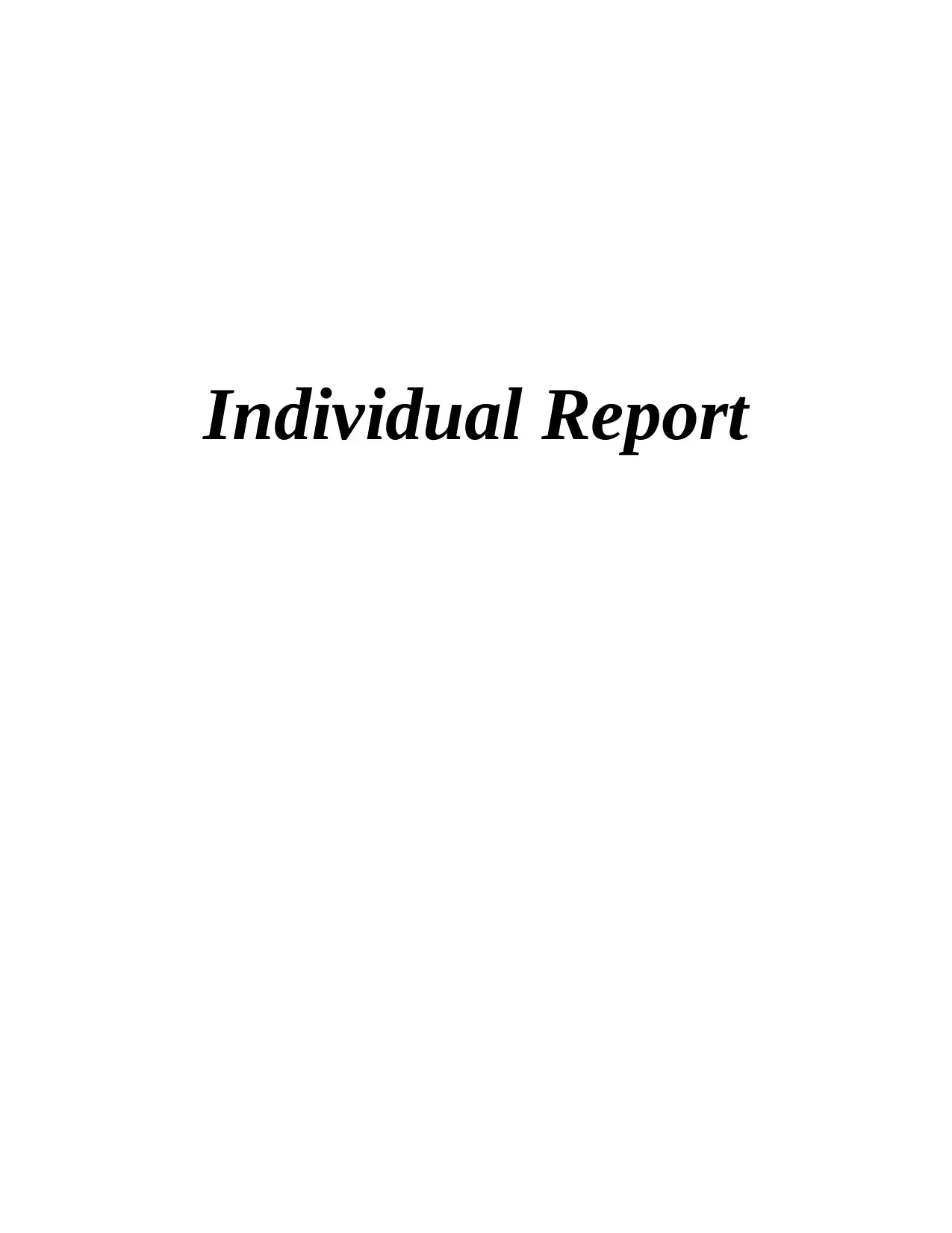
Individual Report
Secure Best Marks with AI Grader
Need help grading? Try our AI Grader for instant feedback on your assignments.

Table of Contents
INTRODUCTION ..........................................................................................................................3
TASK 1............................................................................................................................................3
Enron fraud scandal.....................................................................................................................3
Ethical Corporate Governance....................................................................................................6
Sarbanes Oxley Act, 2002...........................................................................................................6
CONCLUSION ...............................................................................................................................7
REFERENCES................................................................................................................................8
INTRODUCTION ..........................................................................................................................3
TASK 1............................................................................................................................................3
Enron fraud scandal.....................................................................................................................3
Ethical Corporate Governance....................................................................................................6
Sarbanes Oxley Act, 2002...........................................................................................................6
CONCLUSION ...............................................................................................................................7
REFERENCES................................................................................................................................8
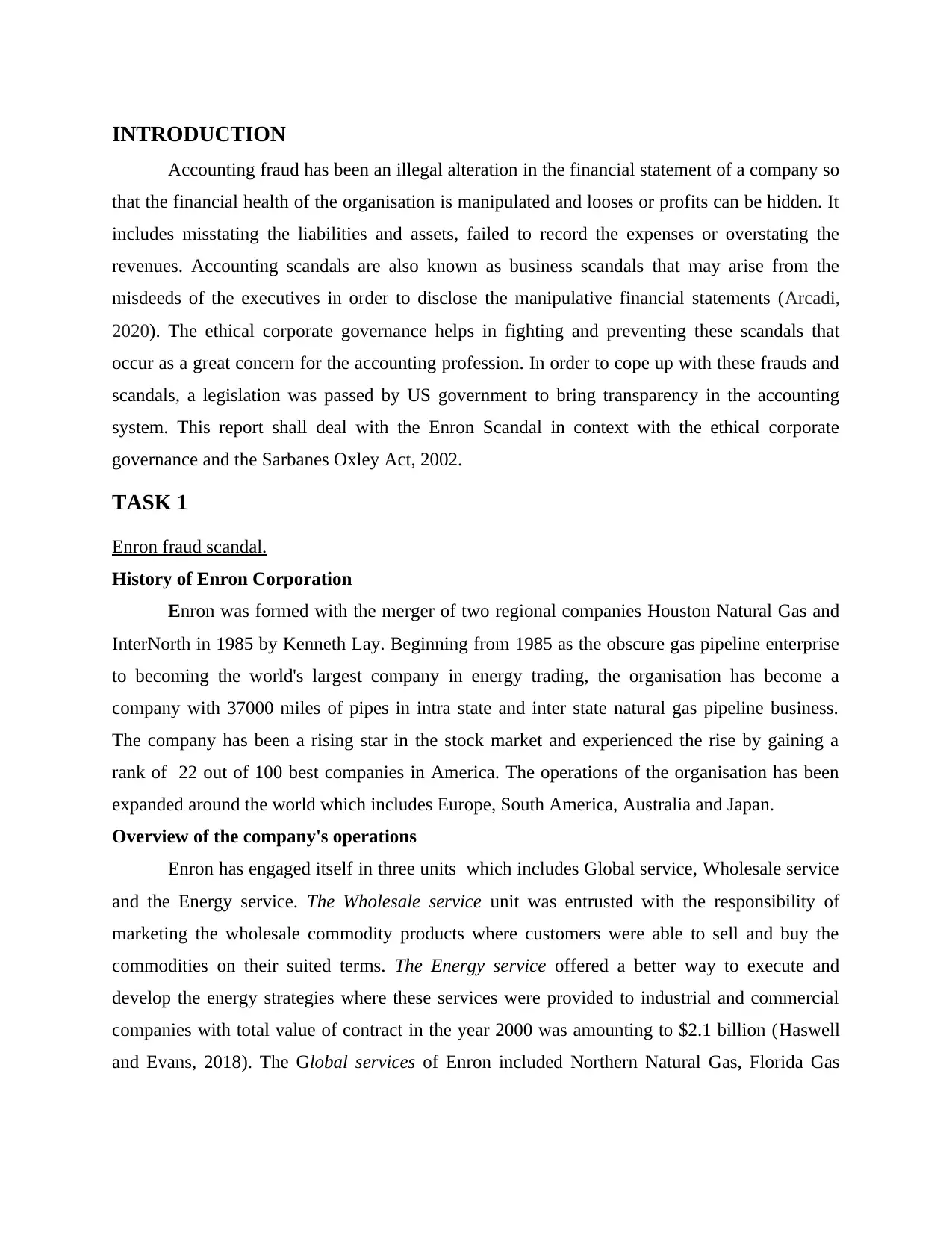
INTRODUCTION
Accounting fraud has been an illegal alteration in the financial statement of a company so
that the financial health of the organisation is manipulated and looses or profits can be hidden. It
includes misstating the liabilities and assets, failed to record the expenses or overstating the
revenues. Accounting scandals are also known as business scandals that may arise from the
misdeeds of the executives in order to disclose the manipulative financial statements (Arcadi,
2020). The ethical corporate governance helps in fighting and preventing these scandals that
occur as a great concern for the accounting profession. In order to cope up with these frauds and
scandals, a legislation was passed by US government to bring transparency in the accounting
system. This report shall deal with the Enron Scandal in context with the ethical corporate
governance and the Sarbanes Oxley Act, 2002.
TASK 1
Enron fraud scandal.
History of Enron Corporation
Enron was formed with the merger of two regional companies Houston Natural Gas and
InterNorth in 1985 by Kenneth Lay. Beginning from 1985 as the obscure gas pipeline enterprise
to becoming the world's largest company in energy trading, the organisation has become a
company with 37000 miles of pipes in intra state and inter state natural gas pipeline business.
The company has been a rising star in the stock market and experienced the rise by gaining a
rank of 22 out of 100 best companies in America. The operations of the organisation has been
expanded around the world which includes Europe, South America, Australia and Japan.
Overview of the company's operations
Enron has engaged itself in three units which includes Global service, Wholesale service
and the Energy service. The Wholesale service unit was entrusted with the responsibility of
marketing the wholesale commodity products where customers were able to sell and buy the
commodities on their suited terms. The Energy service offered a better way to execute and
develop the energy strategies where these services were provided to industrial and commercial
companies with total value of contract in the year 2000 was amounting to $2.1 billion (Haswell
and Evans, 2018). The Global services of Enron included Northern Natural Gas, Florida Gas
Accounting fraud has been an illegal alteration in the financial statement of a company so
that the financial health of the organisation is manipulated and looses or profits can be hidden. It
includes misstating the liabilities and assets, failed to record the expenses or overstating the
revenues. Accounting scandals are also known as business scandals that may arise from the
misdeeds of the executives in order to disclose the manipulative financial statements (Arcadi,
2020). The ethical corporate governance helps in fighting and preventing these scandals that
occur as a great concern for the accounting profession. In order to cope up with these frauds and
scandals, a legislation was passed by US government to bring transparency in the accounting
system. This report shall deal with the Enron Scandal in context with the ethical corporate
governance and the Sarbanes Oxley Act, 2002.
TASK 1
Enron fraud scandal.
History of Enron Corporation
Enron was formed with the merger of two regional companies Houston Natural Gas and
InterNorth in 1985 by Kenneth Lay. Beginning from 1985 as the obscure gas pipeline enterprise
to becoming the world's largest company in energy trading, the organisation has become a
company with 37000 miles of pipes in intra state and inter state natural gas pipeline business.
The company has been a rising star in the stock market and experienced the rise by gaining a
rank of 22 out of 100 best companies in America. The operations of the organisation has been
expanded around the world which includes Europe, South America, Australia and Japan.
Overview of the company's operations
Enron has engaged itself in three units which includes Global service, Wholesale service
and the Energy service. The Wholesale service unit was entrusted with the responsibility of
marketing the wholesale commodity products where customers were able to sell and buy the
commodities on their suited terms. The Energy service offered a better way to execute and
develop the energy strategies where these services were provided to industrial and commercial
companies with total value of contract in the year 2000 was amounting to $2.1 billion (Haswell
and Evans, 2018). The Global services of Enron included Northern Natural Gas, Florida Gas
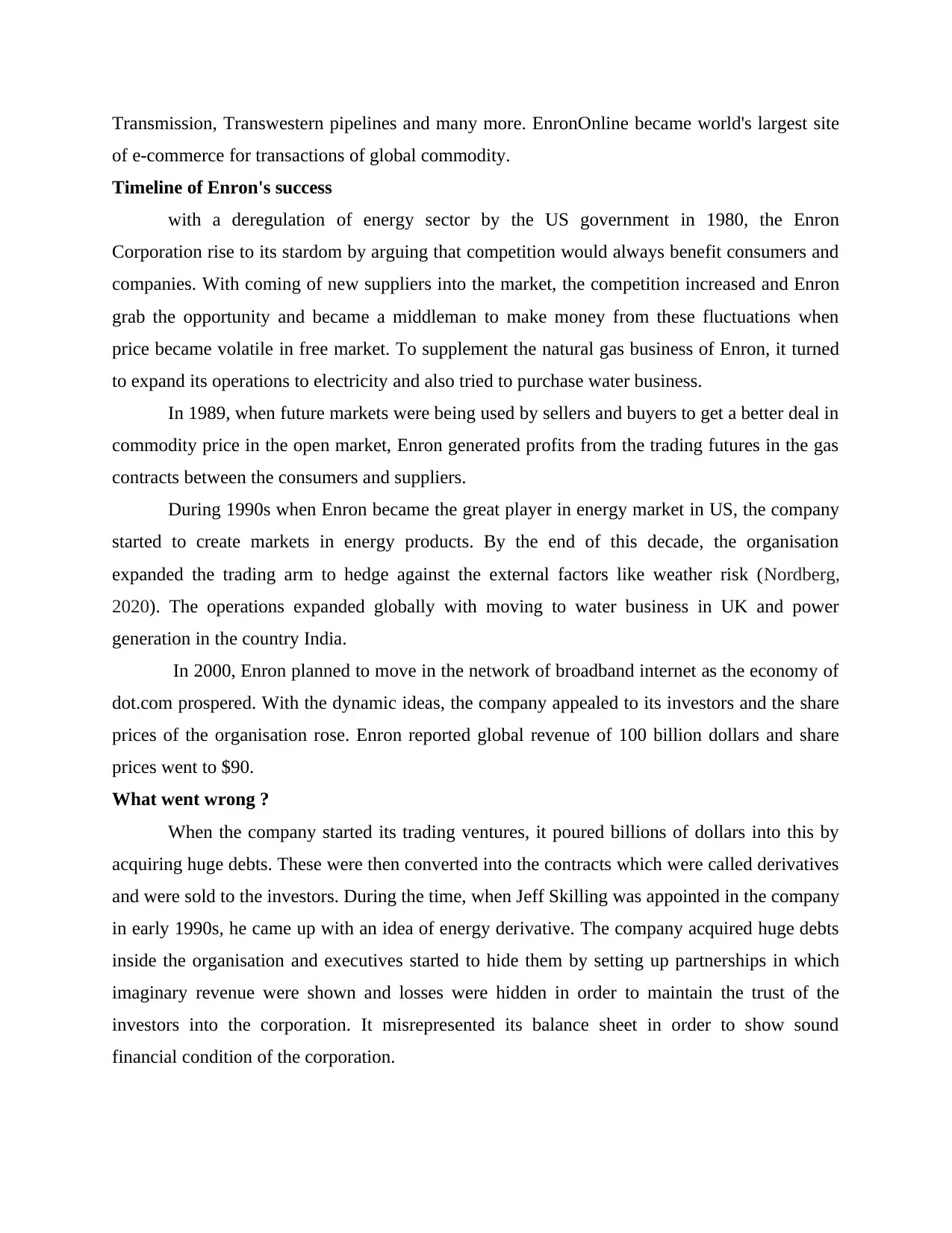
Transmission, Transwestern pipelines and many more. EnronOnline became world's largest site
of e-commerce for transactions of global commodity.
Timeline of Enron's success
with a deregulation of energy sector by the US government in 1980, the Enron
Corporation rise to its stardom by arguing that competition would always benefit consumers and
companies. With coming of new suppliers into the market, the competition increased and Enron
grab the opportunity and became a middleman to make money from these fluctuations when
price became volatile in free market. To supplement the natural gas business of Enron, it turned
to expand its operations to electricity and also tried to purchase water business.
In 1989, when future markets were being used by sellers and buyers to get a better deal in
commodity price in the open market, Enron generated profits from the trading futures in the gas
contracts between the consumers and suppliers.
During 1990s when Enron became the great player in energy market in US, the company
started to create markets in energy products. By the end of this decade, the organisation
expanded the trading arm to hedge against the external factors like weather risk (Nordberg,
2020). The operations expanded globally with moving to water business in UK and power
generation in the country India.
In 2000, Enron planned to move in the network of broadband internet as the economy of
dot.com prospered. With the dynamic ideas, the company appealed to its investors and the share
prices of the organisation rose. Enron reported global revenue of 100 billion dollars and share
prices went to $90.
What went wrong ?
When the company started its trading ventures, it poured billions of dollars into this by
acquiring huge debts. These were then converted into the contracts which were called derivatives
and were sold to the investors. During the time, when Jeff Skilling was appointed in the company
in early 1990s, he came up with an idea of energy derivative. The company acquired huge debts
inside the organisation and executives started to hide them by setting up partnerships in which
imaginary revenue were shown and losses were hidden in order to maintain the trust of the
investors into the corporation. It misrepresented its balance sheet in order to show sound
financial condition of the corporation.
of e-commerce for transactions of global commodity.
Timeline of Enron's success
with a deregulation of energy sector by the US government in 1980, the Enron
Corporation rise to its stardom by arguing that competition would always benefit consumers and
companies. With coming of new suppliers into the market, the competition increased and Enron
grab the opportunity and became a middleman to make money from these fluctuations when
price became volatile in free market. To supplement the natural gas business of Enron, it turned
to expand its operations to electricity and also tried to purchase water business.
In 1989, when future markets were being used by sellers and buyers to get a better deal in
commodity price in the open market, Enron generated profits from the trading futures in the gas
contracts between the consumers and suppliers.
During 1990s when Enron became the great player in energy market in US, the company
started to create markets in energy products. By the end of this decade, the organisation
expanded the trading arm to hedge against the external factors like weather risk (Nordberg,
2020). The operations expanded globally with moving to water business in UK and power
generation in the country India.
In 2000, Enron planned to move in the network of broadband internet as the economy of
dot.com prospered. With the dynamic ideas, the company appealed to its investors and the share
prices of the organisation rose. Enron reported global revenue of 100 billion dollars and share
prices went to $90.
What went wrong ?
When the company started its trading ventures, it poured billions of dollars into this by
acquiring huge debts. These were then converted into the contracts which were called derivatives
and were sold to the investors. During the time, when Jeff Skilling was appointed in the company
in early 1990s, he came up with an idea of energy derivative. The company acquired huge debts
inside the organisation and executives started to hide them by setting up partnerships in which
imaginary revenue were shown and losses were hidden in order to maintain the trust of the
investors into the corporation. It misrepresented its balance sheet in order to show sound
financial condition of the corporation.
Secure Best Marks with AI Grader
Need help grading? Try our AI Grader for instant feedback on your assignments.
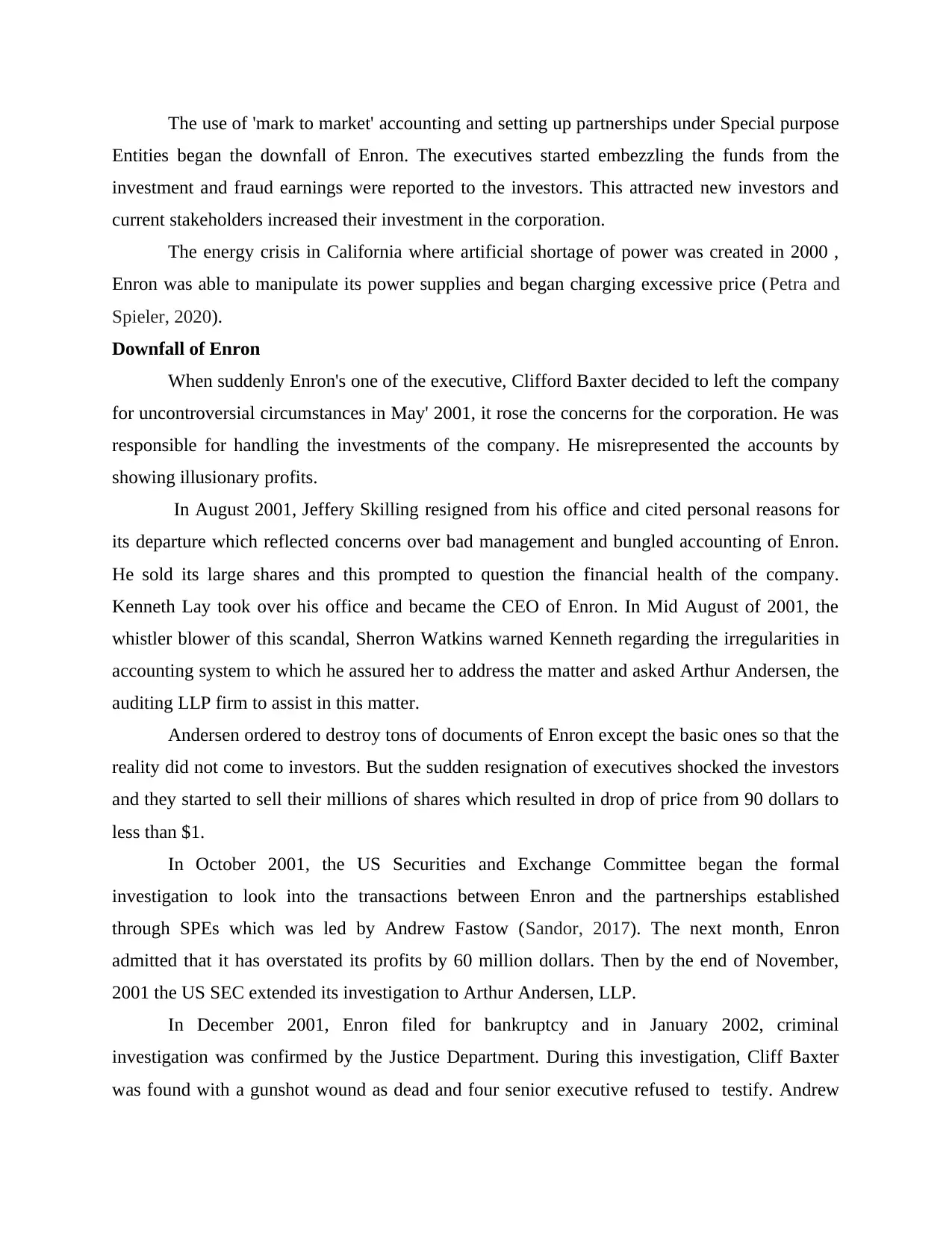
The use of 'mark to market' accounting and setting up partnerships under Special purpose
Entities began the downfall of Enron. The executives started embezzling the funds from the
investment and fraud earnings were reported to the investors. This attracted new investors and
current stakeholders increased their investment in the corporation.
The energy crisis in California where artificial shortage of power was created in 2000 ,
Enron was able to manipulate its power supplies and began charging excessive price (Petra and
Spieler, 2020).
Downfall of Enron
When suddenly Enron's one of the executive, Clifford Baxter decided to left the company
for uncontroversial circumstances in May' 2001, it rose the concerns for the corporation. He was
responsible for handling the investments of the company. He misrepresented the accounts by
showing illusionary profits.
In August 2001, Jeffery Skilling resigned from his office and cited personal reasons for
its departure which reflected concerns over bad management and bungled accounting of Enron.
He sold its large shares and this prompted to question the financial health of the company.
Kenneth Lay took over his office and became the CEO of Enron. In Mid August of 2001, the
whistler blower of this scandal, Sherron Watkins warned Kenneth regarding the irregularities in
accounting system to which he assured her to address the matter and asked Arthur Andersen, the
auditing LLP firm to assist in this matter.
Andersen ordered to destroy tons of documents of Enron except the basic ones so that the
reality did not come to investors. But the sudden resignation of executives shocked the investors
and they started to sell their millions of shares which resulted in drop of price from 90 dollars to
less than $1.
In October 2001, the US Securities and Exchange Committee began the formal
investigation to look into the transactions between Enron and the partnerships established
through SPEs which was led by Andrew Fastow (Sandor, 2017). The next month, Enron
admitted that it has overstated its profits by 60 million dollars. Then by the end of November,
2001 the US SEC extended its investigation to Arthur Andersen, LLP.
In December 2001, Enron filed for bankruptcy and in January 2002, criminal
investigation was confirmed by the Justice Department. During this investigation, Cliff Baxter
was found with a gunshot wound as dead and four senior executive refused to testify. Andrew
Entities began the downfall of Enron. The executives started embezzling the funds from the
investment and fraud earnings were reported to the investors. This attracted new investors and
current stakeholders increased their investment in the corporation.
The energy crisis in California where artificial shortage of power was created in 2000 ,
Enron was able to manipulate its power supplies and began charging excessive price (Petra and
Spieler, 2020).
Downfall of Enron
When suddenly Enron's one of the executive, Clifford Baxter decided to left the company
for uncontroversial circumstances in May' 2001, it rose the concerns for the corporation. He was
responsible for handling the investments of the company. He misrepresented the accounts by
showing illusionary profits.
In August 2001, Jeffery Skilling resigned from his office and cited personal reasons for
its departure which reflected concerns over bad management and bungled accounting of Enron.
He sold its large shares and this prompted to question the financial health of the company.
Kenneth Lay took over his office and became the CEO of Enron. In Mid August of 2001, the
whistler blower of this scandal, Sherron Watkins warned Kenneth regarding the irregularities in
accounting system to which he assured her to address the matter and asked Arthur Andersen, the
auditing LLP firm to assist in this matter.
Andersen ordered to destroy tons of documents of Enron except the basic ones so that the
reality did not come to investors. But the sudden resignation of executives shocked the investors
and they started to sell their millions of shares which resulted in drop of price from 90 dollars to
less than $1.
In October 2001, the US Securities and Exchange Committee began the formal
investigation to look into the transactions between Enron and the partnerships established
through SPEs which was led by Andrew Fastow (Sandor, 2017). The next month, Enron
admitted that it has overstated its profits by 60 million dollars. Then by the end of November,
2001 the US SEC extended its investigation to Arthur Andersen, LLP.
In December 2001, Enron filed for bankruptcy and in January 2002, criminal
investigation was confirmed by the Justice Department. During this investigation, Cliff Baxter
was found with a gunshot wound as dead and four senior executive refused to testify. Andrew
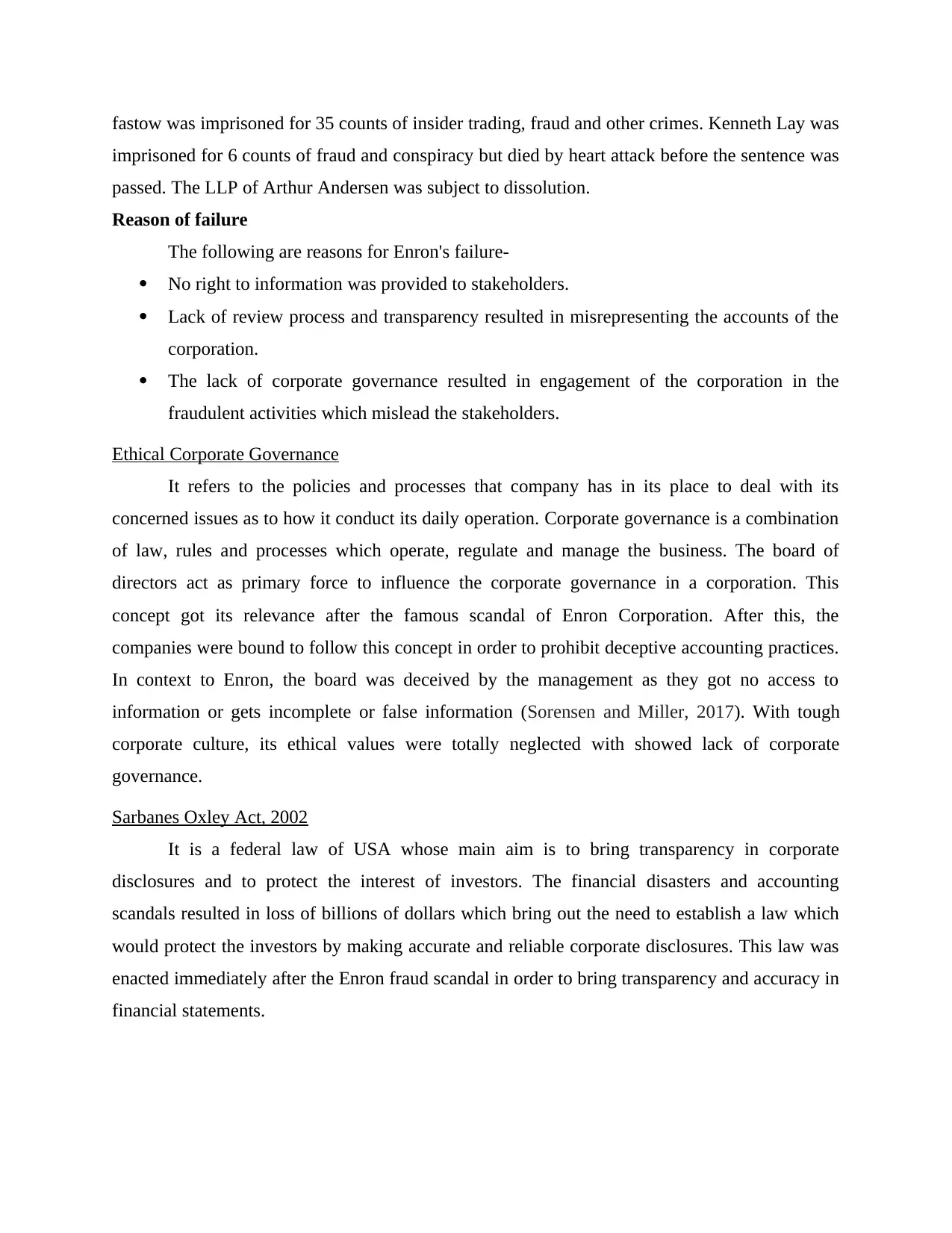
fastow was imprisoned for 35 counts of insider trading, fraud and other crimes. Kenneth Lay was
imprisoned for 6 counts of fraud and conspiracy but died by heart attack before the sentence was
passed. The LLP of Arthur Andersen was subject to dissolution.
Reason of failure
The following are reasons for Enron's failure-
No right to information was provided to stakeholders.
Lack of review process and transparency resulted in misrepresenting the accounts of the
corporation.
The lack of corporate governance resulted in engagement of the corporation in the
fraudulent activities which mislead the stakeholders.
Ethical Corporate Governance
It refers to the policies and processes that company has in its place to deal with its
concerned issues as to how it conduct its daily operation. Corporate governance is a combination
of law, rules and processes which operate, regulate and manage the business. The board of
directors act as primary force to influence the corporate governance in a corporation. This
concept got its relevance after the famous scandal of Enron Corporation. After this, the
companies were bound to follow this concept in order to prohibit deceptive accounting practices.
In context to Enron, the board was deceived by the management as they got no access to
information or gets incomplete or false information (Sorensen and Miller, 2017). With tough
corporate culture, its ethical values were totally neglected with showed lack of corporate
governance.
Sarbanes Oxley Act, 2002
It is a federal law of USA whose main aim is to bring transparency in corporate
disclosures and to protect the interest of investors. The financial disasters and accounting
scandals resulted in loss of billions of dollars which bring out the need to establish a law which
would protect the investors by making accurate and reliable corporate disclosures. This law was
enacted immediately after the Enron fraud scandal in order to bring transparency and accuracy in
financial statements.
imprisoned for 6 counts of fraud and conspiracy but died by heart attack before the sentence was
passed. The LLP of Arthur Andersen was subject to dissolution.
Reason of failure
The following are reasons for Enron's failure-
No right to information was provided to stakeholders.
Lack of review process and transparency resulted in misrepresenting the accounts of the
corporation.
The lack of corporate governance resulted in engagement of the corporation in the
fraudulent activities which mislead the stakeholders.
Ethical Corporate Governance
It refers to the policies and processes that company has in its place to deal with its
concerned issues as to how it conduct its daily operation. Corporate governance is a combination
of law, rules and processes which operate, regulate and manage the business. The board of
directors act as primary force to influence the corporate governance in a corporation. This
concept got its relevance after the famous scandal of Enron Corporation. After this, the
companies were bound to follow this concept in order to prohibit deceptive accounting practices.
In context to Enron, the board was deceived by the management as they got no access to
information or gets incomplete or false information (Sorensen and Miller, 2017). With tough
corporate culture, its ethical values were totally neglected with showed lack of corporate
governance.
Sarbanes Oxley Act, 2002
It is a federal law of USA whose main aim is to bring transparency in corporate
disclosures and to protect the interest of investors. The financial disasters and accounting
scandals resulted in loss of billions of dollars which bring out the need to establish a law which
would protect the investors by making accurate and reliable corporate disclosures. This law was
enacted immediately after the Enron fraud scandal in order to bring transparency and accuracy in
financial statements.
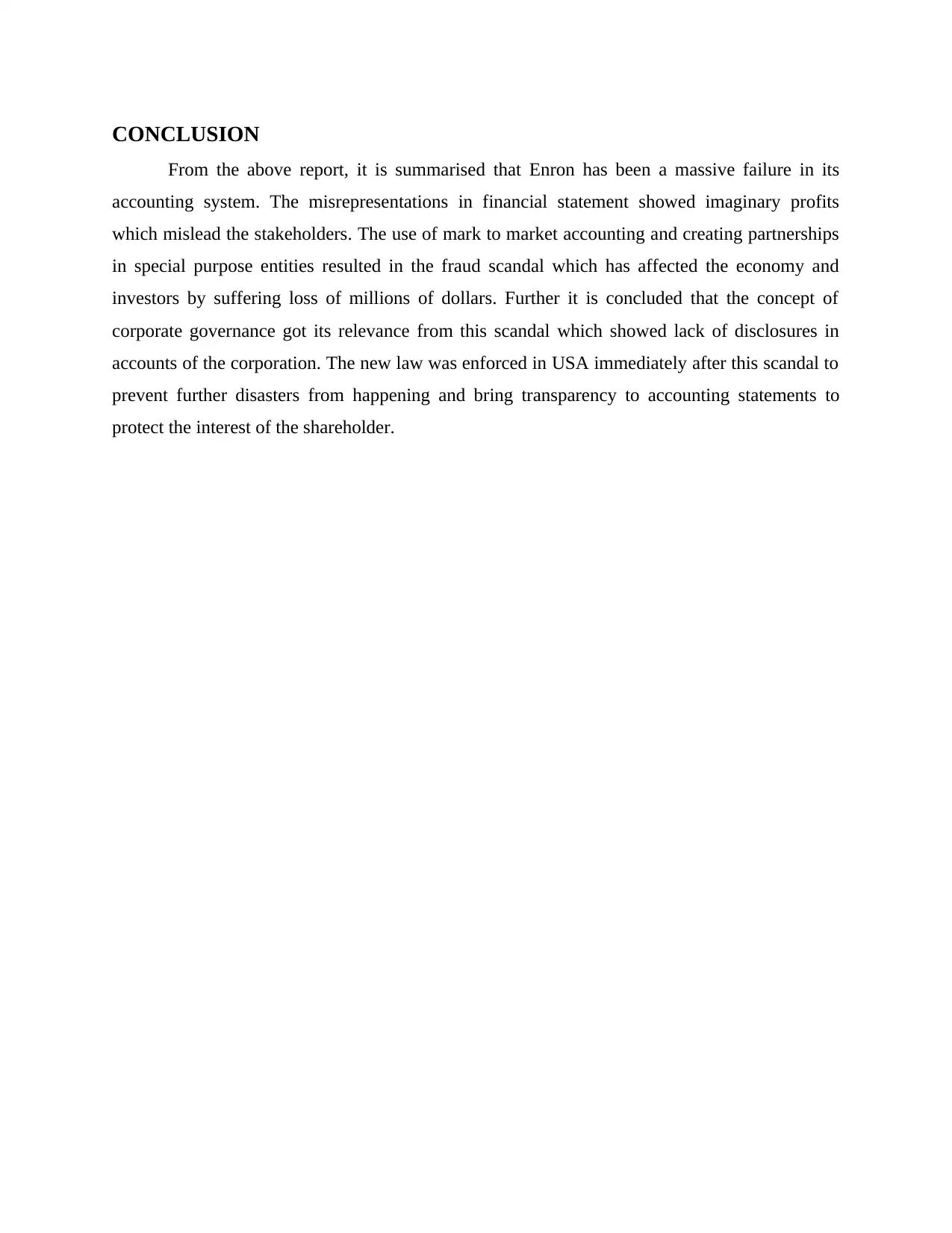
CONCLUSION
From the above report, it is summarised that Enron has been a massive failure in its
accounting system. The misrepresentations in financial statement showed imaginary profits
which mislead the stakeholders. The use of mark to market accounting and creating partnerships
in special purpose entities resulted in the fraud scandal which has affected the economy and
investors by suffering loss of millions of dollars. Further it is concluded that the concept of
corporate governance got its relevance from this scandal which showed lack of disclosures in
accounts of the corporation. The new law was enforced in USA immediately after this scandal to
prevent further disasters from happening and bring transparency to accounting statements to
protect the interest of the shareholder.
From the above report, it is summarised that Enron has been a massive failure in its
accounting system. The misrepresentations in financial statement showed imaginary profits
which mislead the stakeholders. The use of mark to market accounting and creating partnerships
in special purpose entities resulted in the fraud scandal which has affected the economy and
investors by suffering loss of millions of dollars. Further it is concluded that the concept of
corporate governance got its relevance from this scandal which showed lack of disclosures in
accounts of the corporation. The new law was enforced in USA immediately after this scandal to
prevent further disasters from happening and bring transparency to accounting statements to
protect the interest of the shareholder.
Paraphrase This Document
Need a fresh take? Get an instant paraphrase of this document with our AI Paraphraser
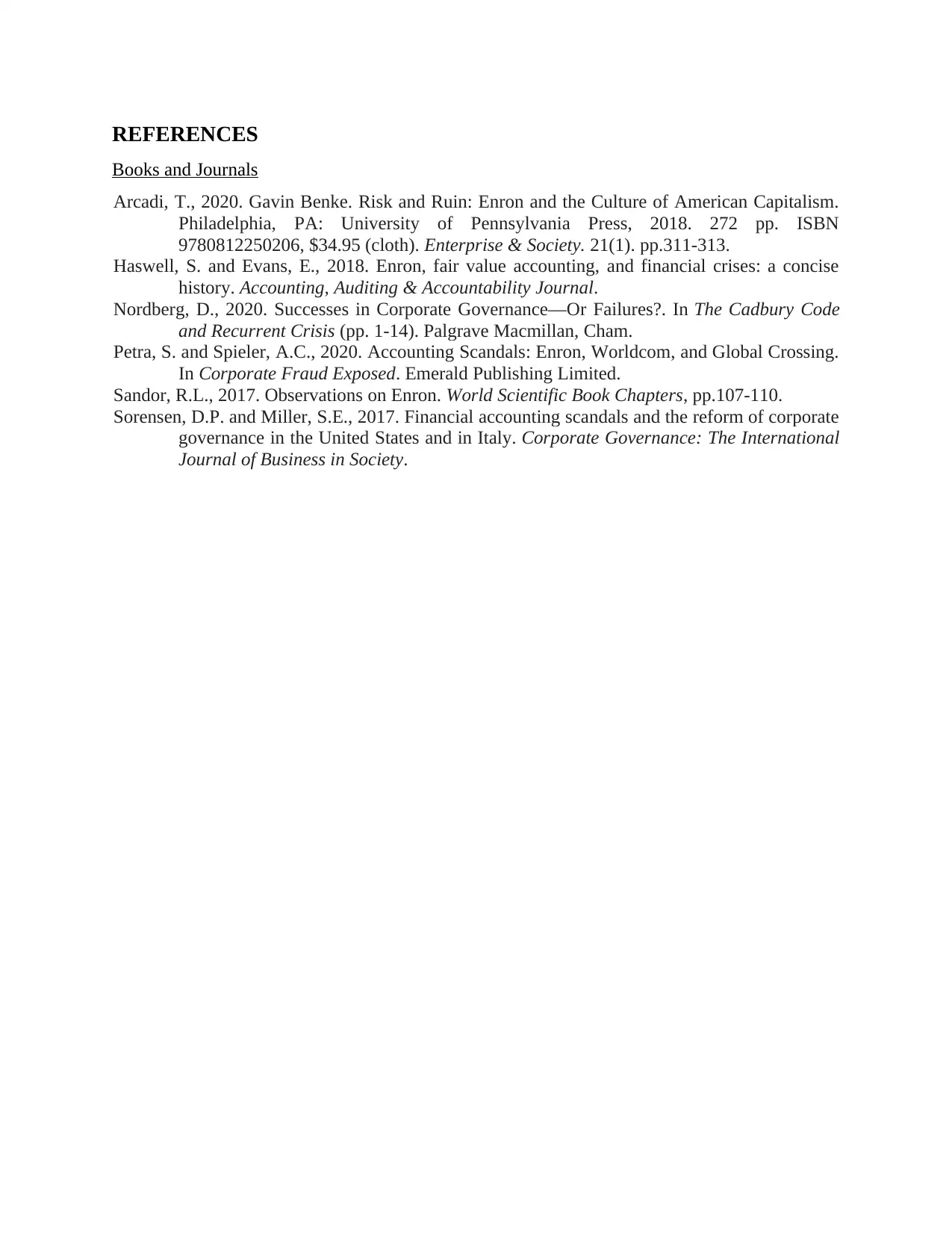
REFERENCES
Books and Journals
Arcadi, T., 2020. Gavin Benke. Risk and Ruin: Enron and the Culture of American Capitalism.
Philadelphia, PA: University of Pennsylvania Press, 2018. 272 pp. ISBN
9780812250206, $34.95 (cloth). Enterprise & Society. 21(1). pp.311-313.
Haswell, S. and Evans, E., 2018. Enron, fair value accounting, and financial crises: a concise
history. Accounting, Auditing & Accountability Journal.
Nordberg, D., 2020. Successes in Corporate Governance—Or Failures?. In The Cadbury Code
and Recurrent Crisis (pp. 1-14). Palgrave Macmillan, Cham.
Petra, S. and Spieler, A.C., 2020. Accounting Scandals: Enron, Worldcom, and Global Crossing.
In Corporate Fraud Exposed. Emerald Publishing Limited.
Sandor, R.L., 2017. Observations on Enron. World Scientific Book Chapters, pp.107-110.
Sorensen, D.P. and Miller, S.E., 2017. Financial accounting scandals and the reform of corporate
governance in the United States and in Italy. Corporate Governance: The International
Journal of Business in Society.
Books and Journals
Arcadi, T., 2020. Gavin Benke. Risk and Ruin: Enron and the Culture of American Capitalism.
Philadelphia, PA: University of Pennsylvania Press, 2018. 272 pp. ISBN
9780812250206, $34.95 (cloth). Enterprise & Society. 21(1). pp.311-313.
Haswell, S. and Evans, E., 2018. Enron, fair value accounting, and financial crises: a concise
history. Accounting, Auditing & Accountability Journal.
Nordberg, D., 2020. Successes in Corporate Governance—Or Failures?. In The Cadbury Code
and Recurrent Crisis (pp. 1-14). Palgrave Macmillan, Cham.
Petra, S. and Spieler, A.C., 2020. Accounting Scandals: Enron, Worldcom, and Global Crossing.
In Corporate Fraud Exposed. Emerald Publishing Limited.
Sandor, R.L., 2017. Observations on Enron. World Scientific Book Chapters, pp.107-110.
Sorensen, D.P. and Miller, S.E., 2017. Financial accounting scandals and the reform of corporate
governance in the United States and in Italy. Corporate Governance: The International
Journal of Business in Society.
1 out of 8
Related Documents
Your All-in-One AI-Powered Toolkit for Academic Success.
+13062052269
info@desklib.com
Available 24*7 on WhatsApp / Email
![[object Object]](/_next/static/media/star-bottom.7253800d.svg)
Unlock your academic potential
© 2024 | Zucol Services PVT LTD | All rights reserved.





